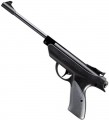Barrel length
The working length of the barrel installed in the pistol / revolver is from the chamber to the muzzle. In airsoft models (primarily AEGs, see "Type"), the length of the inner barrel is indicated, along which the bullet directly moves. Three main points directly depend on this parameter: the initial velocity of the bullet, the length of the aiming line and the dimensions of the weapon.
In short-barreled (up to 20 – 25 cm) pneumatics and Flaubert's revolvers, a long barrel allows you to achieve higher initial speeds. However there is no rigid dependence here, and models with the same barrel sizes can differ markedly in initial speed (especially since the latter also depends on a number of parameters, primarily the principle of operation — see "Type"). However, long-barreled pistols are generally better for long-range shooting than short-barreled pistols. This is due to the second nuance — the length of the sighting line: a long barrel allows you to increase the distance between the front sight and the whole, thereby reducing errors in aiming. However, with regard to dimensions, the increase in the length of the barrel not only makes the weapon more cumbersome, but also worsens its balance, since the centre of gravity shifts forward because of this.
There are a couple more nuances associated with this indicator. So, in copies of combat pistols (see above), the barrel length is selected in accordance with the size of the weapon from which this model wa...s copied. And for products chambered for a blank cartridge (see "Type"), this parameter is not indicated at all, since there is virtually no full-fledged barrel in such pistols.
Adjustable trigger
The ability to customize the characteristics of the trigger installed in the pistol. At a minimum, we are talking about setting the pressing force; in addition, in most cases, you can also adjust the idle length (distance from the starting position to operation).
This function allows you to adjust the characteristics of the descent to the personal preferences of the shooter, make the weapon as comfortable as possible and, accordingly, improve the accuracy of shooting. At the same time, the adjustment mechanism noticeably complicates the design of the weapon and affects its cost. So it makes sense to use such mechanisms only in models with a long barrel length and high muzzle velocity, designed for high-precision sports shooting. As a result,
adjustable trigger models are found mostly among sport (professional) level air pistols. Note that this function in principle does not make sense in starting pistols.
Material
The material from which the body of the gun is made.
The main materials found nowadays are metal and plastic. At the same time, the division into
metal and
plastic cases is actually relevant only for pneumatics; models for "flobert" and for a blank cartridge (see "Type") are almost all made of metal. As for the features of each of the materials, they are as follows:
— Metal. The key advantages of metal are strength, reliability and similarity to materials used in firearms. Such cases weigh much more than plastic ones, but this moment is also often referred to as an advantage — it further enhances the resemblance to combat pistols / revolvers, creates a sense of solidity and allows you to effectively practice skills in working with weapons. The main disadvantage of metal is its rather high cost. In addition, note that the composition of this material may be different: in particular, in low-cost models, a lighter and cheaper, but less durable silumin or other similar alloy can be used instead of steel.
Separately, it should be said that in some modern firearms (in particular, Glock) only the casing-bolt is made of metal, and the frame and handle are made of plastic. For air pistols and starting pistols made of similar materials, our catalog also lists metal as the body material in order to emphasize the similarity with combat prototypes.
— Plastic. Material used mainly
...in low-cost models of pneumatics. In this case, it means a body made entirely of plastic — including a casing-shutter, if available in the design. The main advantage of this material in this case is its low cost — this determined the specifics of its application. On the other hand, plastic is noticeably inferior to metal in terms of strength and reliability, and the small weight of such cases is considered by many to be a disadvantage — the weapon is perceived as a "toy". However there are also advanced varieties of plastic — durable, heat-resistant, suitable even for military weapons; however, in pneumatics, such materials are used in rather expensive copies of real pistols, where a plastic frame is combined with a metal casing-bolt — and such cases are already considered metal (see above).